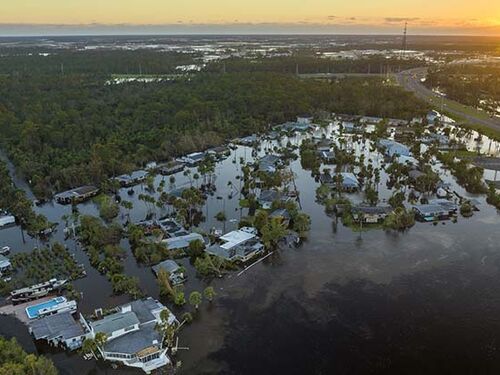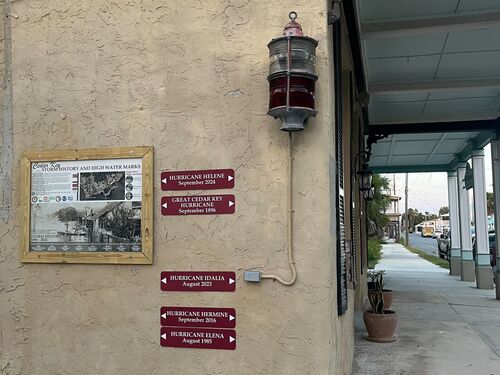Amidst Compounding Disasters, Resilient Housing Can Anchor Communities
Program News
By Benjamin Ulrich
Last update December 3, 2024
Back-to-back hurricanes wreaking havoc across huge swaths of the Southeast were yet another sign of the intensifying impacts of climate change. Hurricanes Helene and Milton left a path of destruction that rightly drew attention to a more subtle consequence of the climate crisis: compounding impacts on homes. The nationwide shortage of reliable, affordable housing and the increasing tempo of extreme weather events are separate crises that overlap and magnify each other’s impacts.
On October 25th, the National Academies hosted a Climate Conversation on the intersection between housing and compounding disasters, taking a closer look at these twin challenges, how we might better address them in tandem, and building on a 2024 report exploring the impacts of these disasters on Gulf Coast communities. New York Times reporter Christopher Flavelle moderated a rich discussion between Tracy Kijewski-Correa, Professor of Global Affairs and Civil Engineering and Director of the Pulte Institute for Global Development at the University of Notre Dame, and member of the committee that authored the 2024 report, and Carlos Martín, Project Director of the Remodeling Futures Program at Harvard University's Joint Center for Housing Studies and incoming Vice President for Research and Policy Engagement at Resources for the Future.
The science indicates that climate change is not only increasing intensity of major disasters, but driving disasters to strike in quicker succession, leaving communities to deal with compounding impacts and little time to fully recover between each one. For some areas, the cumulative impacts become so great that they may never recover at all. This is often felt most keenly with housing—without a safe and secure space, families and individuals are even more vulnerable to climate impacts. “Housing is critical infrastructure, and we haven't treated it as such,” said Kijewski-Correa.
Housing policy and stock is shaped by many forces and the relationship between insurers and building codes is especially important in the context of disasters. Building codes help insurers decide where to offer coverage, and insurers can influence codes and standards by adjusting premiums or declining to provide coverage at all. Disasters are upending this delicate relationship. Damages from disasters in several states—including wildfires in California, flooding in Iowa, and hurricanes in Florida—have been so high that insurance premiums have skyrocketed and, in some cases, led major private insurance companies to stop offering homeowner’s insurance in certain areas. “We really need to rethink how private insurers can fit into a broader pool so that we’re actually distributing risks appropriately, but incentivizing… hazard mitigation as part of that insurance schema,” said Martín.
The complex challenges around housing extend far beyond any single community. There is a balancing act between federal, state, and local governments because federal policy is often one-size-fits-all or has a broad regional focus. Current federal housing policy was designed to be reactive, not proactive, and oriented around property values. Modeling, like the kind that informs flood maps, relies on data from past events, and is struggling to keep up with increasingly likely extremes. Both panelists discussed the need to create an environment that enables federal and state governments to empower localities to do what’s best for their communities, ultimately promoting investments today in resilience against tomorrow’s disasters. “There will be more communities across our country needing to be ready in these moments,” said Kijewski-Correa, describing how many places will face certain hazards that simply hadn’t occurred there before. “We can move people, and our country as a whole, to planning for those rainy days on sunny days,” she said.
As seen recently, compounding disasters have disparate impacts and can magnify existing inequities in our system. In fact, Martín pointed out that the most vulnerable communities already live in high-risk areas, may be unable to afford costly upgrades, or may rent and have little agency over necessary upgrades. Yet, even when given the tools they need to understand and mitigate the climate risks, homeowners might not be able to respond fully. At the end of the day, “they still have to take the house that they can afford,” Martín said. The panelists emphasized how policy changes, including retrofit requirements that make existing homes more resilient, should prioritize the most vulnerable, including low-income households and households of color whose presence in high-risk areas is the result of historic discrimination. At the same time, there should be an emphasis on building community, as neighborhoods with higher social cohesion fare better in disasters in the long run.
“The housing and climate crises that we have right now are intertwined,” Martín said. “We have to deal with the affordable housing crisis as much as we deal with the climate crisis.” Natural disasters will continue to strike, amplified by the climate crisis. Collaboration between decision-makers at the federal, state, and local level, in tandem with communities, will be needed to build a future where resilient homes are foundational to climate solutions.




